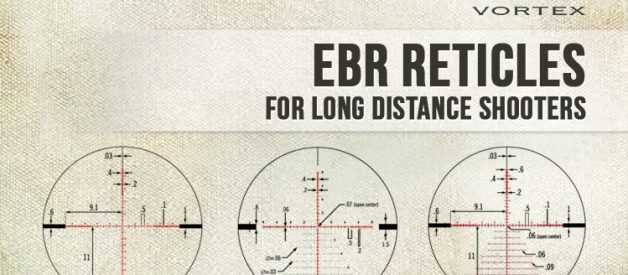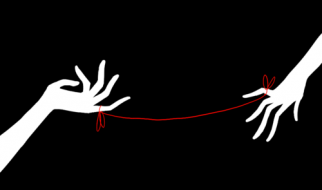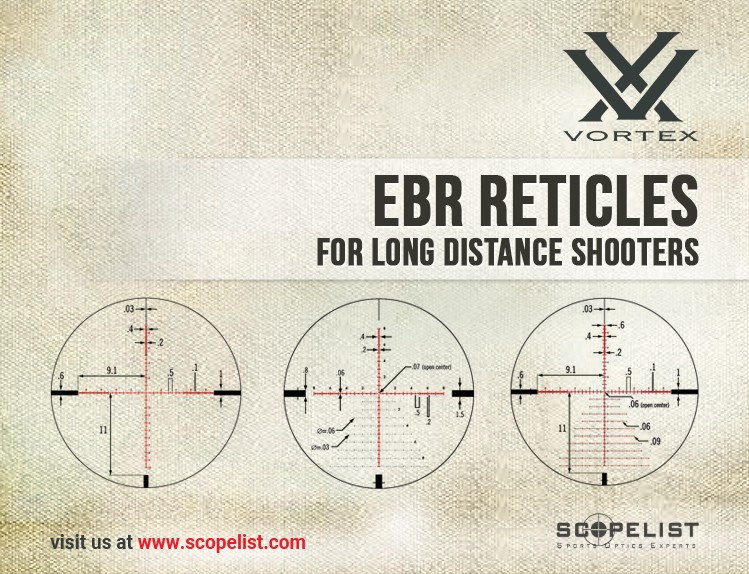
Vortex Optics has designed EBR (Enhanced Battle Reticles) reticles keeping in mind the needs of long distance shooters. With Vortex EBR reticle options, long range shooters can effectively determine ranges, moving target leads, windage, and holdover corrections. Vortex reticle designers have maintained specifications of these reticles at tightest tolerance levels through ultra-precision glass reticle laser etching. For striking the perfect balance between low light visibility and precision in aiming, the Vortex engineers have carefully chosen fine center crosshair subtensions on Vortex EBR MRAD reticles. To help long distance shooters and hunters take the perfect shot, the reticles have been incorporated with windage reference dots on drop lines. Let us check them out.
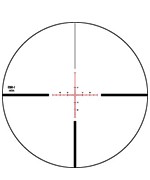
EBR-1 Reticle (MOA)
This Vortex EBR 1 Reticle is a hashmarked ranging reticle that uses MOA based subtension lines for holdover, ranging, and windage corrections. To keep MOA (Minute of Angle) specifications to tightest possible tolerance, Vortex has used ultra precision laser etching on the glass reticle. For providing optimum balance between precision aiming and low light visibility, fine center crosshair subtensions are chosen carefully.
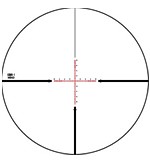
EBR-1 (MRAD) Reticle
MRAD measurement remains constant at all magnifications. All the features are similar to EBR-1 (MOA). The only difference is the measurement metrics. Instead of MOA, it uses MRAD (milliradian) subtension measurement. Determine holdover, range, windage, and moving lead corrections effectively with Vortex EBR-1 MRAD reticle.
MRAD scopes are found to be effective for ranging purposes. These simple formulas below can be used for effective ranging purposes.
- Target Size (Yards) x 1000 / MRADs Read = Range (Yards)
- Target Size (Meters) x 1000 / MRADs Read = Range (Meters)
- Target Size (Inches) x 27.8 / MRADs Read = Range (Yards)
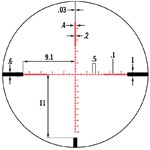
EBR-1C (MRAD)
EBR-1C belongs to the Vortex EBR reticles. It is a hashmarked ranging reticle that uses MRAD-based subtension lines to range, holdover, and windage corrections. This reticle can be found in Vortex Razor Gen II 4.5?2756 riflescope. The image will help you know more about the subtensions.

EBR-2 MRAD Reticle
This is another hashmarked ranging reticle from the Vortex EBR reticle family. MRAD-based subtension lines are used here for holdover, ranging, and windage corrections. Most importantly, you will find windage reference dots on drop lines in EBR-2 reticle (MRAD).

EBR-2B (MRAD) Reticle
Vortex EBR-2B (MRAD) reticle is available with 5 MRAD turrets and 10 MRAD turrets. It comes with heavier windage dot references on drop lines. This feature helps in increasing visibility in all magnifications. In fact, shooters can view the heavier windage dot references even in low light conditions. To enable shooters with the ability of easy as well as quick referencing, numbered subtensions have been used on the crosshairs.
EBR-2C (MOA) and EBR-2C (MRAD) Reticles
You can use the MOA Ranging Formula of Vortex EBR 2C reticle (MOA) to find range in yardage. The formula is:
- Target Size (Inches) x 95.5 / Measured MOAs = Range (Yards)
Vortex EBR-2C reticle is also available in MRAD measurement. The ranging formula used to find range are:
- Target Size (Yards) x 1000 / MRADs Read = Range (Yards)
- Target Size (Meters) x 1000 / MRADs Read = Range (Meters)
- Target Size (Inches) x 27.8 / MRADs Read = Range (Yards)
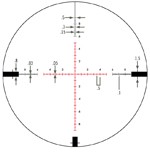
EBR-3 (5 MRAD Turrets) and EBR-3 (10 MRAD Turrets)
Vortex EBR-3 reticle is hashmarked ranging reticle that?s available with both 5 MRAD and 10 MRAD turrets. MRAD-based subtension lines are used here for holdover, ranging, and windage corrections.

EBR-4 (MOA) Tactical
Vortex EBR-4 reticle is available in both MOA and MRAD measurements. Here, the MOA version is given. It is essentially a hashmarked ranging reticle where MRAD-based subtension lines are used for holdover, ranging, and windage corrections. Know more about the subtensions by having a look at the below image of the reticle in Vortex Viper PST 5?2550 riflescope.
Extracting Results From The Given Formulas
To extract result from the formulas, the shooter must know the target?s measured size or even a nearby object. You can either consider horizontal MRAD scale or the vertical MRAD scale. Now, place the reticle on the target, whose measurement is known. Read the MRADs spanned with a steady hold on the rifle. Once you have accurate MRAD reading, you can place the data in the formula and get the result of range. Most accurate ranging can be achieved if the MRAD estimation is done in tenths.
One of the things that shooters need is the correction for bullet drop of cartridge. It becomes very easy to get this estimate once the distance is calculated. As EBR reticles come with MRAD scale, getting the values of bullet drops and windage corrections become easy.
If elevation knob is used to know bullet drops in milliradians, adjustments can be done faster. This is because shooters can read the MRADs on elevation knob quickly. They just need to keep in mind that 1 MRAD is equal to 3.6 inches per 100 yards or 3.44 MOA.
Shooters find Vortex EBR reticles highly effective for targeting moving targets and also for windage corrections. To get thorough knowledge, a shooter needs to check ballistic performance of the weapon system under different weather conditions. The measurement technique is quite similar as in case of bullet drop compensation. Drop line on reticle can be used for basic windage correction. The shooters can use the reticle to correct elevation instead of dialing. In that case, the MRAD marks on center horizontal crosshair can be used to get visual windage correction reference.
Shooters use MRAD marks on center horizontal crosshair of EBR MRAD reticles to get estimate of moving target leads. To estimate moving leads, the things you should know are yardage distance, speed of the moving target, wind speed, and total bullet flight times. Rough calculation of bullet flight times can be done through the calculation on a ballistic calculator or fps velocities.
Summing It Up
These Vortex EBR MRAD reticle options along with the MOA ones are preferred by several long range shooters and hunters across the world. They are equipped with the features required for taking the perfect shot and knowing the exact range. Add Vortex scopes with EBR reticles in your list to effectively determine ranges, moving target leads, windage, and holdover corrections.
Originally published at blog.scopelist.com on May 9, 2017.
